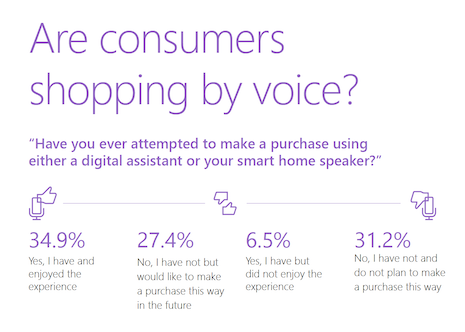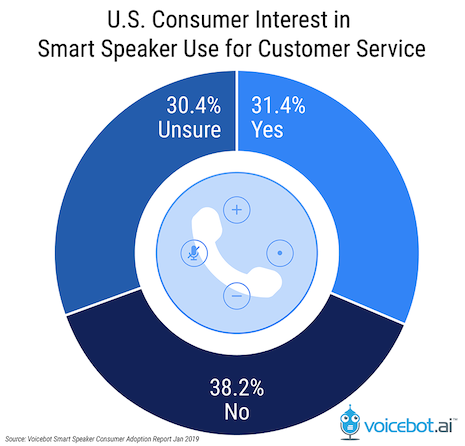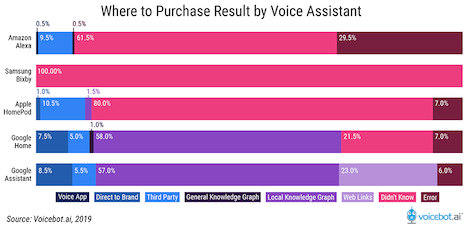 Sources of voice search
Sources of voice search
When we visited the topic of voice-enabled shopping last year, we concluded that brands and businesses looking to take advantage of the new medium would need to do some significant legwork across their ecosystems to promote the capability to customers and have their products appear properly.
While that principle continues to hold true today, much of the landscape around voice shopping has changed materially here this year. Let us dive in.
Velocity of voice shopping behavior is accelerating
Last year, The Information stirred up controversy in the voice world by claiming that only 2 percent of Amazon Echo owners actually used the device to purchase products.
However, the publication also acknowledged Voicebot AI’s 2018 Voice Shopping study, which found the amount of voice shoppers to be 26 percent of smart speaker owners.
While there is certainly ambiguity on the exact number of consumers purchasing through smart speakers, many studies have cited a range of figures with 20 percent surfacing as an acceptable figure to use.
There are strong signals that this behavior is growing.
In December, eMarketer forecast that 27 percent of consumers will shop using smart speakers in 2019. However, in July of 2019, eMarketer raised its estimates and noted the acceleration of shopping behavior occurring on devices.
 Smart speaker shoppers. Source: eMarketer
Smart speaker shoppers. Source: eMarketer
This is all just the smart speaker side of the story.
Voice shopping behavior adoption has actually been noted to be significantly higher through assistants on mobile smartphones.
A recent Microsoft Bing Ads study says that 40 percent of its respondents (2,000 global consumers) have sought to make purchases through their voice assistants on either their phones or smart speakers.
Furthermore, the study found that “54 percent of users believe that digital assistants will help them make retail purchases within 5 years.”
 Microsoft study on consumers shopping by voice. Source: Microsoft Bing
Microsoft study on consumers shopping by voice. Source: Microsoft Bing
Voice shopping: Broad activity, specific sales
When it comes to voice, the term “shopping” encompasses far more than just purchasing an item.
Voice users are turning to their assistants for many points along their buying journey including product research, price comparison, adding to cart and more.
An Adobe Digital Insights report states that “Nearly half (47 percent) of smart speaker owners reported using one to initiate product search and research, 43 percent said they use them for creating shopping lists, and 32 percent do so for price comparison.”
Amid the strong signs of opportunity for fully supported voice shopping journeys is the current truth that the majority of items being purchased by users are digital products such as music, movies and other media or goods that do not require a tactile evaluation, specifically common consumer packaged goods that consumers are already familiar with and are comfortable reordering.
 Voice shopping activities on smart speakers. Source: eMarketer
Voice shopping activities on smart speakers. Source: eMarketer
Underscoring this point is Voicebot AI’s finding in its Voice Shopping Consumer Adoption Report that “over 85 percent of voice purchases were for $100 or less. Voice is being used for everyday transactions and is not yet viewed as a channel for higher priced items.”
Brand preparation for voice-first shopping
With all this growth in commerce through voice, brands have clearly shown an intent to heavy up their investments to capture value.
In a study of 400 business decision makers, Adobe found that “91 percent are already making significant investments in voice; 94 percent plan to increase their investment in the coming year.”
However, with all this activity, brands will need to make sure they address a few core areas of digital readiness.
The first area is customer service.
Increasingly, consumers are considering voice as a medium to reach companies’ support centers just as they would any other channel.
According to Voicebot AI, up to 60 percent of consumers could be interested in using voice-enabled devices to contact customer service departments.
Another key area is discoverability and search engine optimization.
A recent study done by Uberall found that only 3.8 percent of businesses currently offered correct information in voice searches. Gaining and maintaining visibility through these platforms will be critical to stay competitive with other products going forward.
 Consumer interest in smart speaker use for customer service. Source: voicebot.ai
Consumer interest in smart speaker use for customer service. Source: voicebot.ai
The larger issue that needs to be addressed is trust and privacy.
Microsoft’s study found that “41 percent of users report concerns around trust, privacy and passive listening.”
So it is best practice for brands to be extremely transparent with what user data is being collected and how it is being used, as well as providing users some control over these factors.
 Where to purchase result by voice assistant. Source: voicebot.ai
Where to purchase result by voice assistant. Source: voicebot.ai
AS WE HEAD toward 2020, companies keeping tabs on voice shopping’s maturation should remember that although the usage is increasing, consumer behavior indicates that, in the near-term, a significant volume of purchases will be smaller monetary amounts and often consist of digital products.
However, this may change quickly as familiarity with the voice shopping experience develops and privacy concerns are abated.
Savvy organizations and brands will continue to optimize their voice assistant experiences across both mobile and smart speaker surfaces with an eye toward emerging avenues such as the car, point of sale and advertising channels.
 Will Hall is chief creative officer of Rain
Will Hall is chief creative officer of Rain
Matt Lang is strategy director and Will Hall is chief creative officer, both of Rain, New York.
